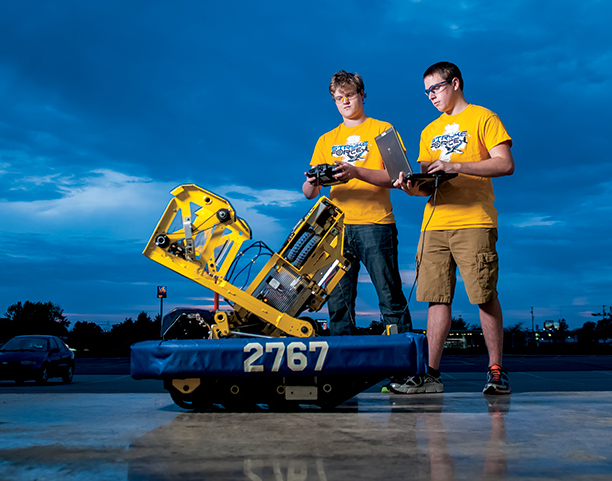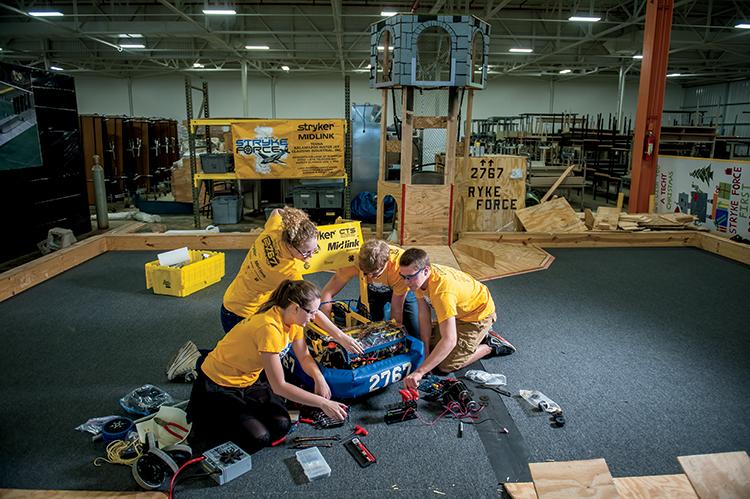Home > Michigan > Michigan Ag Education > Innovative Robotics Competition Encourages Michigan Ag Students
Innovative Robotics Competition Encourages Michigan Ag Students
In partnership with: Michigan Department of Agriculture & Rural Development

Ever heard of a Segway? Dr. Dean Kamen, who is best known for inventing the popular electric-powered personal human transporters, is also responsible for creating For Inspiration and Recognition of Science and Technology, commonly called FIRST. It is the leading not-for-profit STEM (science, technology, engineering and math) engagement program for kids worldwide.
Founded in 1989, the program is open to students in kindergarten through high school. The FIRST Lego League Jr. serves kids in grades K-3, while the FIRST Lego League comprises older elementary students starting in fourth grade. Middle school students participate in FIRST Tech Challenges, and high schoolers can showcase their skills in FIRST Robotics Competitions, during which mentor-led teams design and build robots and compete in district and statewide events – and possibly in the worldwide FIRST Championship.
“Dean Kamen looked at the United States and thought that innovation was not being celebrated in the way that sports and entertainment were,” says Gail Alpert, president of FIRST in Michigan. “He wanted inventors and scientists to be seen as heroes the way that professional athletes and celebrities are, so he decided to make science a ‘sport’ through robotics competitions. In fact, FIRST is the only varsity sport where every kid can turn pro.”
Unforgettable Experiences
According to Alpert, more than 450 high schools in Michigan will have a FIRST Robotics team in 2017, which is more than any other state lays claim to. There are also a small number of community-based teams in the state that are not associated with a particular school, and that’s the case with Stryke Force in Kalamazoo.
Stryke Force, operating under the 4-H umbrella and sponsored by medical devices and equipment manufacturing firm Stryker Corp., comprises one high school team with students from 12 different high schools in the Kalamazoo area, plus two junior high school teams and an elementary school team.
Jerry Culp, vice president of global development at Stryker Corp., serves as one of the high school team’s mentors, working alongside the students throughout the year, especially during the six weeks prior to a FIRST Robotics Competition. This is the timeframe participants have to design and build their remote-controlled robots.
“From a time commitment standpoint, preparing to compete is just as intense as two-a-day football practices,” Culp says. “This is an enormous amount of work.”
After the six weeks have ended, FIRST students must seal their robots in a bag until they compete in their first of two district events. Teams accumulating the most points move on to state championships, followed by the FIRST Championship, where the top teams from around the globe compete each year.
“We’ve gone to the world championship for the past couple of years,” Culp says. “Between 40,000 and 50,000 people show up to watch 600 FIRST teams compete, and during the final matches, I guarantee those spectators get louder than any Friday night football crowd.”

FIRST Prepares Participants
Although FIRST involves building robots, students leave the program with far more than robotics knowledge.
Karley Reed, a senior at Kalamazoo Central High School, says her three years as a FIRST participant with Stryke Force have helped her learn to “work efficiently and effectively with others” and sharpened her leadership skills. In addition, Reed says she didn’t know what she wanted to pursue in college when she began her journey with FIRST, but now has plans to obtain a bachelor of science degree in mechanical engineering.
“When kids come out of FIRST, not only have they been exposed to many facets of STEM, they have figured out which ones they’re good at and which ones they enjoy,” Culp says. “They also learn to work on a team, and they get to learn valuable lessons in an environment where the consequences are reasonably minor. This program is changing lives in a huge way.”



